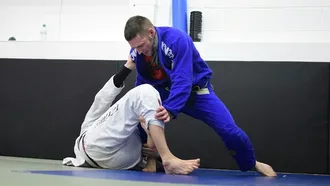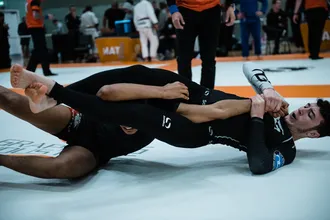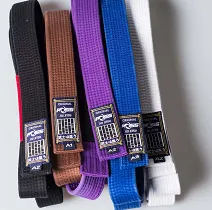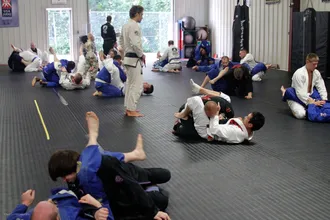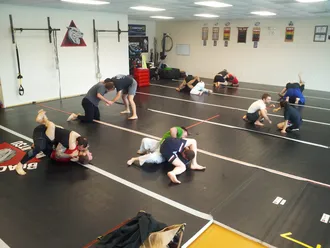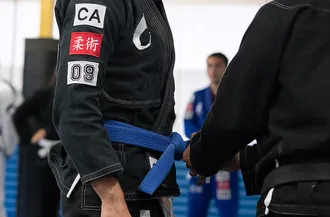
Be patient, have fun, learn the basics. Enjoy the journey. Don’t be in a rush to get your blue belt, to get your first stripe, to get your purple belt. It’s going to come, but you have to be patient.
Wondering how long it takes to get a blue belt in BJJ? You're in the right place. For many practitioners, the blue belt is their first major milestone in Brazilian Jiu-Jitsu, marking the transition from beginner to intermediate level.
The BJJ blue belt is the second rank in the BJJ belt system, coming after white belt and before purple, brown, and black belt. Interestingly, most students quit before reaching blue belt, making it a significant achievement.
Unlike other martial arts where belt promotions can happen quickly, earning a blue belt in BJJ requires years of consistent training, live sparring, and technical proficiency. This ensures that each rank truly represents a practitioner’s skill level.
Every belt in BJJ is a testament to dedication and perseverance. The rigorous training process makes these belts highly respected within the martial arts community, emphasizing skill, strategy, and real-world application over simple memorization of techniques.
How Long Does It Take to Get a Blue Belt in BJJ?
Quick Answer - The time to earn a BJJ blue belt varies, but here’s a general timeline:
- ⏰ Typical Range: 1-3 years of consistent training
- ⏳ Training Frequency: 2-3 classes per week can lead to promotion in the average expected time.
- ⚡ Fast-Track Options: Extra open mats, private lessons, and competition success
On average, it takes between 1 to 3 years of consistent training to earn a BJJ blue belt. However, this timeline is not fixed—progress varies based on factors like training frequency, personal dedication, and the grading standards of your BJJ academy.
For those attending BJJ classes 2-3 times per week, a promotion within this timeframe is reasonable. However, if you train more frequently, participate in open mats, or take private lessons, you may accelerate your progress.
While many practitioners are eager to reach blue belt quickly, remember that BJJ is about skill development, not just belt promotions. The journey itself—learning techniques, refining strategies, and improving through live sparring—is what truly matters.
What Affects Your Journey to a BJJ Blue Belt?
While the average BJJ blue belt timeline is 1-3 years, progression isn't solely about time spent on the mat. Several key factors influence how quickly you earn your blue belt.
Developing proficiency in core techniques, understanding BJJ principles, and consistently applying them in live sparring are just as important as training frequency.
Additionally, factors like competing in local tournaments, previous experience in Judo, wrestling, or other grappling martial arts can accelerate your progression, as they provide a strong foundation for positional control and takedowns.
Consistency: The Key to BJJ Progression
When it comes to earning a BJJ blue belt, consistency is everything. Regular training helps you refine techniques, understand movement patterns, and develop muscle memory.
Beyond technique, consistency also plays a vital role in physical conditioning. Strength, flexibility, and endurance all improve through frequent and structured practice, making you a more effective grappler.
Mindset and Dedication: The Mental Game of BJJ
Jiu-Jitsu is as much mental as it is physical. To reach blue belt, you need more than just mat time—you need resilience, discipline, and a willingness to learn.
Setbacks are inevitable. Whether it’s injuries, life commitments, or personal struggles, time away from the mats can slow progress. However, the ability to adapt and return stronger is what separates those who reach blue belt from those who quit.
The Blue Belt Mindset: What Separates Those Who Quit from Those Who Keep Going
Reaching blue belt isn’t just about technique, it’s about how you approach training. Here’s what separates successful practitioners from those who quit:
- Train with Purpose: Focus on one improvement per session instead of just showing up.
- Roll with Tougher Opponents: Getting tapped by higher belts means you’re learning.
- Don’t Chase the Belt: Progress is about skill, not stripes or promotions.
- Keep Showing Up: The best grapplers aren’t always the most talented—they’re the most consistent.
Overcoming Setbacks in BJJ
Life happens, maybe you might move home, start a family, or need recover from an injury. Every practitioner faces setbacks at some point. The key isn’t avoiding them, it’s learning how to keep progressing despite them.
Even if you need to take a break, staying engaged by watching instructional videos, drilling techniques solo can help you stay sharp. Some practitioners even use recovery time to focus on mental training: studying matches, analyzing and visualizing techniques, and improving their strategic understanding of Jiu-Jitsu.
Remember, consistency over time is what matters. A short break won’t erase your progress but quitting will.
Key Techniques Every BJJ Blue Belt Should Know
Achieving a blue belt means more than just training for a certain amount of time. It requires a solid foundation in both offensive and defensive techniques. Here are some of the essential skills you should master:
Fundamental Escapes
A blue belt must be able to escape from bad positions effectively. Essential escapes include:
- Shrimping (Hip Escape) – A fundamental movement for creating space and recovering guard.
- Bridge and Roll – A key escape from the mount position.
- Side Control Escapes – Essential for regaining control when pinned.
"If you're in a room full of white belts, and some of those white belts are pinning you down and holding you down as long as they want – you're not ready for blue belt."
Guard Passing &Retention
Blue belts should have a solid understanding of passing the guard and maintaining guard retention. Key techniques include:
- Knee Slide Pass – A staple for cutting through an opponent’s guard.
- Toreando Pass – A movement-based pass that allows you to bypass an opponent’s legs.
- Guard Retention – A blue belt should be able to maintain and recover their guard effectively and prevent easy passes.
Sweeps
A good blue belt should be comfortable executing sweeps to reverse positions. Fundamental sweeps include:
- Scissor Sweep – A simple yet effective sweep from guard.
- Hip Bump Sweep – A great transition into a dominant position.
- Tripod Sweep - An open guard sweep using a combination of foot placement and off-balancing to knock a standing opponent.
Submissions
While blue belts are still developing submission proficiency, they should be able to confidently execute:
- Armbar – One of the most common and effective submissions from almost everywhere.
- Triangle Choke – A must-know submission from the guard.
- Rear-Naked Choke – A high-percentage submission from back control.
Positional Control & Transitions
Beyond submissions, blue belts must understand positional control, including:
- Takedowns – A fundamental way to take the fight to the ground.
- Mount Control – Holding dominant positions and preventing escapes.
- Back Takes – Smoothly transitioning to and retaining the most dominant position in BJJ.
Ultimately, earning a blue belt isn’t just about learning techniques—it’s about applying them effectively under pressure. With a strong mix of offensive and defensive skills, a blue belt sets the foundation for higher levels of Jiu-Jitsu.
Why the BJJ Blue Belt Matters
Earning a BJJ blue belt is a major milestone in your Jiu-Jitsu journey. It represents more than just a new rank—it’s proof that you've built a strong foundation in the art.
A blue belt signifies that you can effectively apply fundamental techniques, defend yourself using BJJ principles, and hold your own against less experienced practitioners.
More importantly, it marks your transition from a beginner to an intermediate grappler—someone who understands not just how techniques work but also when and why to use them.
Reaching this level takes dedication, discipline, and consistency, making it a meaningful and rewarding accomplishment.
Why Work Toward a Blue Belt in BJJ?
Brazilian Jiu-Jitsu is more than just a martial art—it’s a path to self-improvement. Working toward your blue belt isn’t just about learning submissions and escapes; it’s about developing:
- Discipline & Mental Toughness – Pushing through tough training sessions builds resilience.
- Problem-Solving Skills – BJJ is like a physical chess match, requiring strategy and adaptability.
- Confidence & Self-Defense – A blue belt gives you the ability to defend yourself in real-world situations.
- Physical Fitness – BJJ improves strength, flexibility, endurance, and cardiovascular health.
By striving for a blue belt, you’re not just improving your grappling—you’re working toward a healthier, stronger version of yourself.
FAQs: Common Questions About the BJJ Blue Belt
How long does it take to get a blue belt in BJJ?
On average, it takes 1-3 years of consistent training to earn a blue belt. Training frequency, dedication, and academy standards all play a role.
Is a BJJ blue belt dangerous?
A blue belt has enough knowledge to apply effective submissions and control opponents, but they are still learning. Against untrained individuals, a blue belt is highly effective.
What should a BJJ blue belt know?
A blue belt should have a solid foundation in escapes, guard passing, sweeps, submissions, and basic positional control.
Start or Continue Your BJJ Journey Today
Whether you're just starting BJJ or wondering if you should keep going, remember this: the journey to a blue belt is filled with personal growth, new challenges, and rewarding achievements.
Every roll, every class, every struggle on the mat brings you one step closer—not just to a belt, but to a better version of yourself.
Start training, keep rolling, and enjoy the process. Whether you're stepping onto the mats for the first time or working toward your next belt, your journey is yours to own. Show up, improve daily, and before you know it—you'll be tying on that blue belt.
Ready to take the next step? Find a class and train today.
